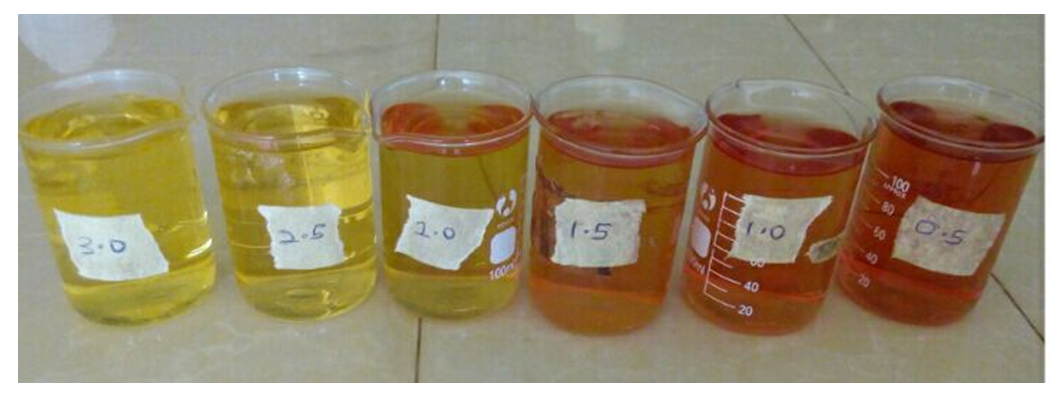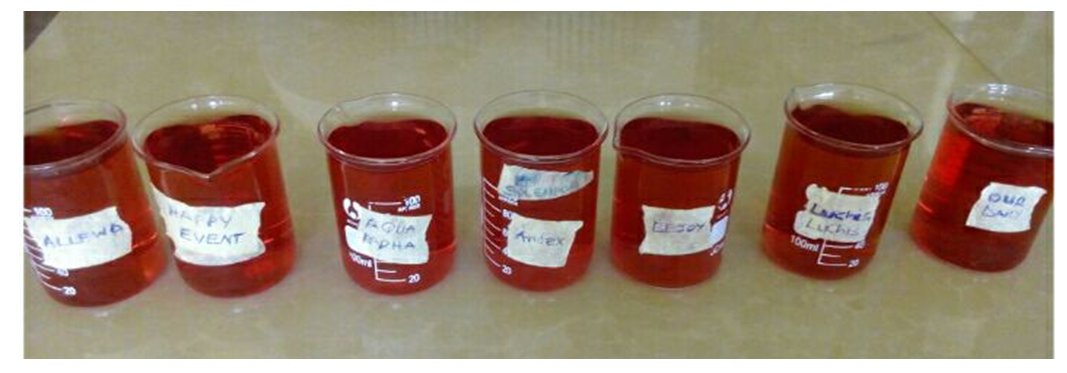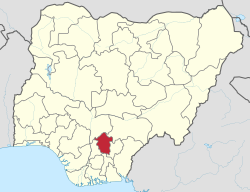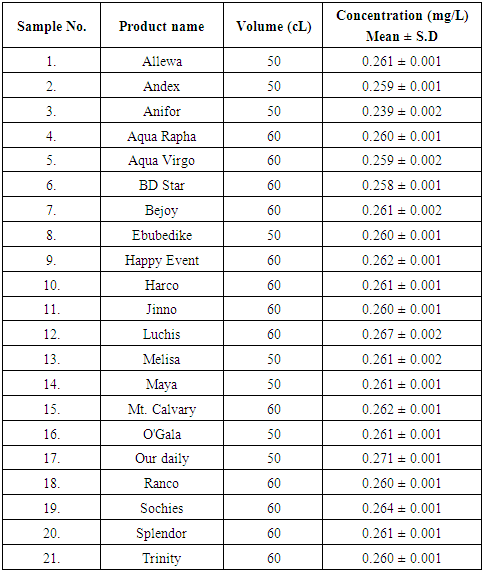-
Paper Information
- Paper Submission
-
Journal Information
- About This Journal
- Editorial Board
- Current Issue
- Archive
- Author Guidelines
- Contact Us
Advances in Analytical Chemistry
p-ISSN: 2163-2839 e-ISSN: 2163-2847
2018; 8(1): 10-14
doi:10.5923/j.aac.20180801.03

Analysis of Fluoride Concentration in Commercial Sachet Water Brands in Enugu, Nigeria
Ichu Chigozie Bright, Agulana Albert Chibuzo
Materials and Energy Technology Department, Projects Development Institute (PRODA), Emene Industrial Area, Enugu, Nigeria
Correspondence to: Ichu Chigozie Bright, Materials and Energy Technology Department, Projects Development Institute (PRODA), Emene Industrial Area, Enugu, Nigeria.
| Email: |  |
Copyright © 2018 The Author(s). Published by Scientific & Academic Publishing.
This work is licensed under the Creative Commons Attribution International License (CC BY).
http://creativecommons.org/licenses/by/4.0/

Due to the heavy reliance on sachet water for drinking and the widespread use of consumer products containing fluoride in Nigeria, it has become necessary to monitor fluoride levels in sachet drinking water. Water packaged into polyethylene sachets (as a form of water vending) is sold for drinking in Enugu, southeast Nigeria. There is no indication of fluoride levels in these sachet water brands. Fluoride levels of 21 sachet drinking water brands sold in Enugu metropolis were determined in duplicate using the Zirconium-Alizarin red-S-spectrophotometric method. The results were obtained from linear regression of the calibration curve. The range of fluoride levels in tested samples was between 0.239 mg/L - 0.271 mg/L. ANOVA and t- test conducted showed that the differences between the fluoride levels in the sachet drinking brands were statistically significant (p< 0.05). The paired samples t-test showed a non-significant difference between the first and second reading of each batch, p-value, 0.662>0.05. The fluoride concentration levels determined were below the level for optimally fluoridated water. The results obtained confirm the need for more careful monitoring of fluoride levels in sachet water and the need to fluoridate water for good oral health.
Keywords: Fluoride content, Sachet drinking water, Alizarin red spectrometric analysis, Enugu
Cite this paper: Ichu Chigozie Bright, Agulana Albert Chibuzo, Analysis of Fluoride Concentration in Commercial Sachet Water Brands in Enugu, Nigeria, Advances in Analytical Chemistry, Vol. 8 No. 1, 2018, pp. 10-14. doi: 10.5923/j.aac.20180801.03.
Article Outline
1. Introduction
- The sale of bottled water in Nigeria has been on the increase since 2016 when 28.9 billion litres worth 938.6 billion naira was sold. This increase has been largely fueled by combined forces of a hot weather and an inadequate pipe-borne water supply in Nigeria. Furthermore, poor road infrastructure and traffic management which result in extended hours on the roads in many Nigerian cities have made the availability of on-the-go cold and packaged water a huge relief for thirst. The growth of the bottled water industry in addition, has been consolidated by the fact that this type of water packaged in flexible nylon sachets (although production conditions maybe poor) is cheap and affordable [1]. Since water is a veritable source of fluoride in human diet, and considering its importance in dental public health, fluoride levels in drinking water should be known. The regrettable fact is that this information is lacking at the national level in Nigeria [2]. The Nigerian Standard for Drinking Water Quality as well as the World Health Organization have a maximum permitted value of 1.5 mg/L for fluoride in drinking water [3,4]. This parameter is also indicated as one of the routine monitoring parameters that needs to be controlled on a regular basis [3]. Fluoride is a naturally occurring substance in water [5]. It has been shown, that with all the human exposure to fluoride in the air, soil and water, drinking water is the largest single contributor to daily human fluoride intake. [6] As a result, daily human fluoride ingestions (mg/kg of body weight are based on fluoride levels in the drinking water and water consumption per day per litter) [6]. Fluoride in optimal levels in water is known to prevent dental caries by regular consumption through various means but more predominantly by deposition of calcium fluoride crystals which is more resistant to enamel erosion by oral bacteria [7]. The World Health Organization (W.H.O) has identified dental caries as a worldwide epidemic and also recommended to add fluoride to drinking water in naturally occurring water which has less than optimal fluoride levels (0.7 to 1.2 mg F/L) [8]. The occurrence of fluoride content of water above the maximum permitted limits may lead to risk of skeletal and dental fluorosis and increased risk of dental caries when the value is lower than the permitted level [9]. The inability of the public water works in Enugu southeast Nigeria to provide adequate and consistent drinking water for the whole populace have driven the people to packaged water as an ever ready source of drinking water [11]. Sachet water is produced in no fewer than 100 factories across Enugu state, southeast Nigeria [12]. Since sachet water is the primary source of drinking water in Enugu, it is important to know the concentration of fluoride in this ubiquitous sachet water. The aim of this study therefore is to determine the fluoride levels in commercially available sachet water brands in Enugu metropolis since none have nutritional content labelling.
2. Materials and Method
- 21 sachet water brands sold by water vendors in Enugu metropolis in the month of July 2016 were purchased in two different batches and taken to the Chemical Analysis Laboratory of Projects Development Institute (PRODA) Enugu. Fluoride content of each sample was determined in duplicate with a UV spectrophotometer following the procedure outlined by [13].Preparation of Reagent Solution (Standard Fluoride Solution)1.5 g ammonium hydrogen difluoride (NH4F.HF) was weighed and dissolved in distilled water and diluted to 1000 cm3 in a volumetric flask. This solution contains 1,000 mg L-1 Fluoride. A serial dilution of the stock solution was done to obtain solutions containing 0.5, 1, 1.5, 2, 2.5, 3, 3.5 mg L-1 Fluoride. These were used to obtain the calibration curve and the linear regression equation which was used to obtain the fluoride content of the sachet water samples.Alizarin Red Solution0.75 g alizarin red was weighed and dissolved in distilled water and made to 1000 cm3 in a volumetric flask.Zirconyl Acid Solution:0.345 g of Zirconyl Chloride was weighed and dissolved in about 800 cm3 distilled water, then 33.30 cm3 concentrated H2SO4 was slowly added and stirred, followed by the addition of 101 cm3 HCl, the solution was stirred thoroughly and made up to 1000cm3 in a volumetric flask.Spectrometric Determination of Fluoride:5.0 cm3 each of alizarin red and zirconyl acid solutions were added to 100 cm3 of both standard and sample solutions, mixed thoroughly and allowed to stand for 60 minutes for full colour development. Absorbance readings were taken at 520 nm with an Amersham Biosciences Biochrom Biotech GE Pharmacia Ultrospec 2100 pro UV-Vis Spectrophotometer.
3. Statistical Analysis
- Fluoride content of the sachet water brands were calculated as mean ± standard deviation. Analysis of variance (ANOVA) and student t-test were done with IBM-SPSS 23 to determine the statistical significance of the variation in the mean value of fluoride levels in various sachet water brands available in Enugu metropolis. The paired samples t-test was done to determine any statistically significant variation between the values of fluoride obtained in the first and second absorbance readings.
 | Figure 1. Fluoride standard solutions + Zirconyl Acid Solution + Alizarin Red Solution |
 | Figure 2. Sachet water samples + Zirconyl Acid Solution + Alizarin Red Solution |
 | Figure 3. Fluoride Standard calibration curve |
 | Figure 4. Map of Nigeria showing southeastern Enugu State |
 | Figure 5. Map of Enugu Town with interest points |
4. Results and Discussion
- The mean fluoride concentration of each sample given in Table 1. The mean of three different batches of the same brand was calculated along with the standard deviation and tabulated. The mean value of fluoride content in the sachet water brands is 0.26 mg/L. with a range from 0.239 – 0.271 mg L-1 which is below the accepted standard for optimally fluoridated water which is 0.7-1.2 mg/L and also below the Nigerian and W.H.O maximum permissible limits for fluoride which is 1.5 mg F/L [3,4]. None of the brands included in the study provided the fluoride content in the labels. The low standard deviations observed in the samples implies low variation of fluoride content among different batches of these brands. The differences observed in the fluoride content of the sachet water brands are statistically significant (p < 0.05). This implies varying fluoride content of sachet water produced in different areas of the city. This fact agrees with the findings of [14] who showed that different zones of Enugu had different values of fluoride for well water. The mean value of fluoride determined in well waters in Enugu was 0.63 mg/L [14]. This decrease observed between the mean fluoride content of these sachet water brands and the mean fluoride content of well waters may be attributable to the purification process of sachet water manufacture.
|
5. Conclusions
- Although the mean fluoride level in sachet drinking water brands in Enugu is currently within safe limits and gives no cause for concern for toxicity effects, it is below the level for optimal caries prevention. This has adverse oral health implications. This also implies that supplemental fluoridation to optimum level is necessary. Standardization of fluoride levels in sachet water brands and labelling of fluoride content by manufacturers should be made mandatory by the food regulatory agency.
 Abstract
Abstract Reference
Reference Full-Text PDF
Full-Text PDF Full-text HTML
Full-text HTML